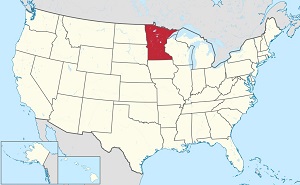Minnesota means clear blue water from the Dakota language. Nearly 60 percent of the
population lives in the Twin Cities of Minneapolis and Saint Paul, the center
of transportation, business, industry, education, government and an
internationally renowned arts community. The remainder of the Land of 10,000 Lakes consists of western
prairies, forests in the southeast and mining, forestry, and recreation in the
North Woods.
The
Twin Cities
besides the Mississippi river, they are also connected by the Metro Green Line
light rail, which runs between Minneapolis’ Target Field and St. Paul’s Union
Depot, with more than 20 stops.
Performing
Arts Minnesota is home to a number of older stages that have been recently
restored
Fergus Falls built in 1921 as the Orpheus, and later known as
the Fergus Theatre, this venue has evolved from vaudeville to film and back to
stage performances. The Center for the Arts remodeled and updated the space in
1995, showcasing a variety of live performances.
St Cloud the Sherman Theatre
opened in 1921 and was renamed as the Paramount in 1930. Like other venues, it transitioned
from vaudeville to cinema to disrepair and renovation, transforming into a
multimedia arts center, keeping the original design, acoustics and decor
intact.
Minneapolis historic venues
include First Avenue with a history of live rock music.
Native
American Heritage indigenous people have lived in what is now
Minnesota for thousands of years. When the Europeans arrived the predominant
American Indian tribe was the Dakota. As explorers and settlers moved west, the
Ojibwe, who lived in the central Great Lakes region, were forced into Dakota Territory.
The resulting migration resulted in the Dakota residing primarily in the
prairies of the Minnesota River Valley and points south and west, while the
Ojibwe inhabited the lakes and forests of north and central Minnesota.
Lakes
and Fishing Minnesota has many bodies of water and more shoreline
than California, Florida and Hawaii combined. The deep, cold waters of Lake
Superior, the world’s largest freshwater lake, offer charter fishing for native
lake trout as well as steelhead, chinook, salmon and walleye. Aside from the
Mississippi, other rivers include the Minnesota, St. Croix and Red River of the
North, where anglers can reel catfish or northern pike, smallmouth bass,
walleye, pan fish and over 100 lesser-known species. Northern pike are one of
the most widespread fish in the state, from the backwaters of the Mississippi
to the wilderness lakes of canoe country.
Minnesota has
4,000 miles of Scenic Paved Biking Trails
The State Park System begins at the source of
America’s greatest river. Itasca State Park, one of 67 state parks, is home to
the headwaters of the Mississippi River, was established in 1891, launching
what is now the second-oldest state park system in the nation. Most are on
lakes or rivers with opportunities for boating, canoeing, fishing and swimming,
with hundreds of miles of hiking trails through forests, bogs, grasslands, and
along riverbanks and lakeshores.
Jay Cooke State Park 20
miles southwest of Duluth, follows the rugged, rocky St. Louis River, which
thunders when the water is high. Whitewater rafting trips are hosted on the
river in nearby Carlton, and the University of Minnesota Duluth runs the Kayak
and Canoe Institute just outside the park boundaries, with classes open to the
public.
The
River Towns of southeast Minnesota are perfect for a weekend packed
with activities. Only 60 miles from the Twin Cities, the town of Red Wing,
tucked between bluffs and river, has many historic Victorian properties and farmhouses.
The St James hotel, dating to the 1880s, offers elegant dining overlooking the
Mississippi River and is near the Amtrak Depot, built in 1904, with an art
gallery and visitor center.
Winona
is an arts and cultural center. The riverside Minnesota Marine Art
Museum, with three major galleries, holds hundreds of fine art pieces,
including works by Picasso, Van Gogh and Monet, depicting lakes, oceans and
rivers. Enjoy a stroll around Lake Winona. The Garvin Heights overlook features
panoramic views of the town and Mississippi River Valley.
New Ulm follow the Minnesota
River Valley Scenic Byway and experience Old World German heritage through
unique architecture, restaurants and shops selling German imports, from chocolates
to cuckoo clocks. A traditional Glockenspiel features figures from the town’s
history; you can also take a narrated history tour downtown.
Wines
and Brews on a scenic estate tucked back into the woods is Schell’s,
the country’s second-oldest family-run brewery. Celebrate the release of
Schell’s seasonal bock beer at the annual Bock Fest on Feb. 6, the same day New
Ulm celebrates Fasching, the German Mardi Gras.The town also offers one of the
state’s best-established vineyards. Weekend visitors can enjoy live music and
pizzas at the countryside winery weekends through December, or at The Grand
Kabaret weekends throughout the winter.
Fitger’ Brewhouse in Duluth
boasts more than 100 beer recipes and a connection to a North Shore brewing
tradition that dates back to the 19th century, A Duluth legend, the brewery's
tanks are scattered throughout the complex and can visited.
Lift Bridge in Stillwater
was the first on-site brewery taproom in Minnesota, part brewery, part
neighborhood hangout, and an opportunity to taste some interesting brews.
Summit Brewing in St Paul is a leader of the modern Minnesota craft beer movement with the release of its ever-popular Extra Pale Ale in 1986. Since its launch, the brewery has expanded both its production facility in St. Paul and its brewing horizons, releasing new year-round and limited-run beers that are among the most popular in the Upper Midwest.
Summit Brewing in St Paul is a leader of the modern Minnesota craft beer movement with the release of its ever-popular Extra Pale Ale in 1986. Since its launch, the brewery has expanded both its production facility in St. Paul and its brewing horizons, releasing new year-round and limited-run beers that are among the most popular in the Upper Midwest.
Minnesota River
Towns Lakes State Parks Performing Arts and Local Brew Traditions

















